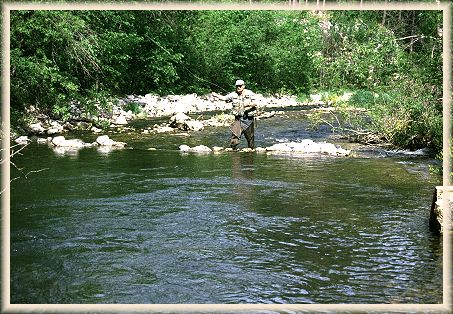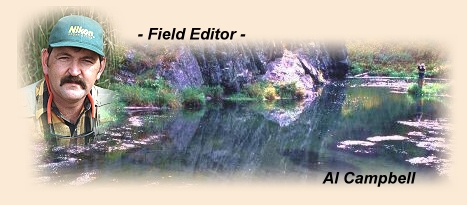|
I considered for a short while doing an article
on the Bighorn River, but at 320 miles away, I
can hardly call it home waters even if it is the
large river I fish most regularly. Home waters
are supposed to be waters you know so intimately
that the guesswork is mostly replaced by knowledge
of the water, its fish and the insect hatches found
there. I can say I know the Bighorn well enough to
predict when most of the hatches will occur generally,
but not well enough to have the intimate knowledge
of all the intricacies of the river. I'll leave
that water to others who call it home on a daily
basis.
This is my last installment in the "Home Waters"
series of articles. I want to strongly encourage
others to do what I have done and continue this
series in what will become a "Home Waters" section
on this site. Why should we let visiting anglers
do all the writing (sometimes with glaring errors)
on the water we treasure? Let's make this the place
where we and others can visit and learn about each
other's favorite fishing places; and why they are
treasures we care deeply about. I have already met
a few people who visited my area and fished my home
waters because they read what I wrote and wanted to
experience it too. Wouldn't it be fun if you could
meet people visiting your area for the same reason?
Let me see what you have in your area that you call
"Home Waters."
This last article is somewhat happy and somewhat sad.
It deals with the smaller streams in my area and some
of those streams lost their aquatic life last summer
during the ongoing drought we have been experiencing.
It also deals with some healthy streams that don't
get much fishing pressure. These are streams I
used to enjoy a lot and some I still enjoy, but
they are smaller and less easy to access than what
I have already written about. Either way, they are
still my home waters and treasures I want to share
with you.
Beaver Creek is small enough I can step over it in
many places, but it has some hungry brookies in it
that rarely see much fishing pressure. It is a
spring creek that runs on both sides of the Wyoming
and South Dakota State line. Late summer hoppers
are as good as it gets to lure these fish from their
hiding places. You won't find a lot of big insect
hatches here, but those insects that do hatch are
met by enthusiastic, hungry trout.
Sand Creek runs on the Wyoming side of the Black
Hills. It is as good a spring creek as you might
ever wish for. Locals usually consider it their
secret place to fish. It is the only stream in
the Black Hills I know of that has a small resident
population of cutthroat trout left over from fish
stocking done long ago. Add some cutt-bows, a few
browns and some brookies and you get a balanced diet
of fishing pleasure. Access is via a gravel road
from the Wyoming town of Beulah on Interstate 90.
Watch your step in the summer; rattlesnakes are
fairly common.
Crow Creek is the largest true spring creek in South
Dakota. It has fairly steady flows all year and runs
cool all the time. Vegetation and difficult stream
banks make fishing difficult, but it can be great
fishing if you can cast well. Browns and rainbows
are the prizes for a well cast fly. Like Sand Creek,
watch your step in the summer. Access is via the
McNenny Fish Hatchery road that intersects I90 about
two miles east of the Wyoming State line.

Elk Creek, Little Elk Creek, Whitewood Creek and Box
Elder Creek all flow northeastward from the north
central regions of the Black Hills between Rapid
City and Deadwood. The lower stretches of all
four streams dried up last summer killing the
fish and aquatic insects they held. The same
stretches have dried up again this year. The
upper portions of each stream still run cool
enough to support brookies and an occasional
brown trout. Fishing has been tough to non-existent
in some of these waters for two summers in a row.
The only picture I'm providing this week is of
Elk Creek above, taken a couple of years ago. The
brookie fishing was excellent that day. Right now,
that part of the stream is nothing but dry rocks.
Like all things, there will be a time of renewal,
but it will require a return of normal moisture
before that can happen.
Slate Creek is a small stream in the central regions
of the Black Hills not far from Hill City. It also
suffers somewhat from stream flow fluctuations due
to drought. Brookies and brown trout are the treats
anglers hope to catch in this stream. The fish aren't
usually really big, but they can be fun, and the
scenery is awesome.
There are other, smaller streams in the Black Hills
that hold trout, mostly brookies. The streams that
flow on the northeastern and eastern edges of the
Black Hills have been hard hit by the drought.
Many are currently dry, but many have good brookie
fishing in the upper regions of their watersheds.
When average flows return and the fish repopulate
the streams, the fishing should be great again.
I didn't include the rivers in my area for a reason.
Most of the access is difficult or impossible because
they flow through private land. I have fished some
of them and enjoyed smallmouth bass and carp fishing
for some big fish. I kept my comments to the streams
that flow through public land where access is public
and easy. I also gave you a slice of the flavor
of our prairie ponds. You'll have to discover
the rest when you visit my area. I invite you
to try them, my home waters. I also invite you
to tell me about your home waters. I'm looking
forward to it.
~ AC
|





